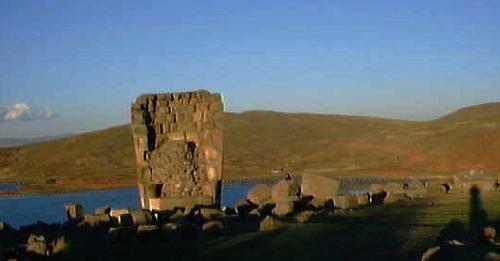
Lima, Arequipa, Puno, Peru

Funerary tower, Sillustani
Thursday 14th - Thursday 21st October 1999
The taxi driver from Lima airport (Jorge Luis Gomez Salazar) turned out to be extremely friendly. When we arrived at the bus station, he went inside the terminal to check whether there were any tickets available for the overnight bus, and if so how much they cost. Lima bus terminals are notorious for theft, and this was an additional service which proved very helpful - he'd tried to explain about it at the airport, but my Spanish wasn't up to understanding what he was trying to tell me. On the way to the terminal he told us that he was in fact himself from Arequipa, and that his sister took in house guests at $15 a night for two including all meals. After a bit of consideration, we decided that this would be a good option, so the taxi driver phoned his sister and told us that she would meet us off the bus in Arequipa. Things were looking decidedly good in Peru.
We had about an hour and a half to kill in Lima before our bus left, and burdened as we were with all our luggage, we decided to wait in the bus terminal. I nipped out to get some supplies for the journey, and we had our first encounter with the famous Inca Cola, Peru's national soft drink. It tastes somewhere between cream soda and Irn Bru, and is a luminescent yellow colour. Apparently the manufacturers have struck a deal with Coca Cola for the distribution of Inca Cola around the world, and it certainly tastes good enough to be a bit of a success.
After having checked our luggage in with the bus company, we got talking to a man who was waiting for the same bus. It's funny how when you're travelling and speaking in a foreign language the same phrases turn up time and again in individual countries: this was the first time I had the opportunity to explain that I'd always dreamed of visiting Machu Picchu and Lake Titicaca, something I would be telling numerous people in Peru before the end of our visit.
We got on the bus after making sure that our luggage was on board and the journey started normally enough as we drove through Lima in the falling darkness. As we approached the highway south, however, we stopped for a short moment and some Peruvian vendors came on board selling gaseosas and papas rellenos. We thought at first that the driver had just stopped to get some snacks, but we sat there for over an hour before turning back towards Lima and stopping again. We were starting to think that we wouldn't get out of Lima that night and that we would have to find somewhere to stay in the dark when finally we started to leave again. It turned out that the driver had committed some sort of traffic offence and then had made matters worse by arguing with the traffic police, who then told him to turn back because he couldn't travel on to Arequipa. I think he then drove back through Lima and took another route in the hope of avoiding the police. In any event, we finally left Lima about three hours after we set out from the bus terminal.
The road south was paved all the way and so was not too uncomfortable, except for the fact that the window beside me wouldn't close properly, and so I had a cold draught blowing into my side all night. Veronika managed to fall asleep quite quickly, but I had a very bad night of it.
As dawn broke we were treated to the slightly bizarre sight of a coastal desert, with the only sign of human existence other than the roadway itself often being the numerous crosses at the side of the road marking the site of a fatal accident - it seems that Peruvian drivers are crazy, and the roads are worse, so they have a very high death rate. Still the scenery was spectacular, although admittedly I was too tired to really appreciate it much.
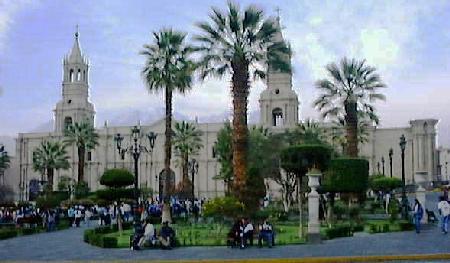
Plaza de Armas, Arequipa, with Misti in the background
We eventually arrived in Arequipa around two or three o'clock, after a mammoth twenty-hour drive, some six hours more than they told us when we bought the tickets. Again, this seems to be a fairly common occurrence.
Waiting for us at the terminal in Arequipa was Anparo Espejo, who was to be our host. We had just got our luggage off the bus when a woman approached us and said "Veronika?" Veronika was really happy to hear her name as we arrived in the town, and it made her feel right at home. Anparo turned out to be an excellent host and we were both heartily pleased that we had happened to get a taxi driver from Arequipa who had a sister who rented out rooms: it was by far the most comfortable place we had stayed in, and was much more pleasant than any hotel - at least one which we could have afforded - would have been, and including three meals a day the price was very reasonable. Anparo has a delightful nine-year-old daughter Fernanda.
After lunch on our arrival, we were driven into town by a friend of Anparo and were shown around the centre. The Plaza de Armas is very attractive, bordered by the cathedral on one side and colonial arched buildings on two other sides, with a very pleasant park in the middle. We went to an Internet cafe so that I could send an email to Eoin to arrange our meeting in Puno. We also visited the amazing polychrome cupola of the San Ignacio chapel in the La Compania church. Flash photography is understandably banned (although one selfish idiot took several pictures with a very powerful flash, despite being told by the senora at the entrance that this was not allowed) as the very delicate frescoes were made with natural dyes several hundred years ago. I took some non-flash pictures which give some idea of the complexity of the designs on the chapel, but the colours are truly impressive and don't come out in the pictures.
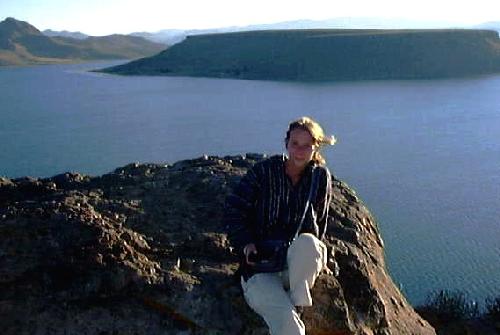
Veronika and Laguna Umayu,
After visiting the chapel we went to a Peruvian supermarket to shop for food and then made our way back to the flat. After dinner, Veronika and I were so tired that we conked out almost immediately and slept extremely well. Before that, we ate some fruit which were new to us, with the chirimoya being particularly delicious.
The next day we caught a lift into town at nine in the morning to visit Santa Catalina. This was a nunnery originally built in 1580 and expanded in the 17th century to house 450 nuns at its peak. It was relatively expensive to get in (nearly $4!) but was well worth it. Almost a city within the city, the complex is large and, well, complex, with numerous squares and six little streets. Some of the walls are painted bright blue, others red, and the whole place is littered with colourful flowers and trees. We were both enchanted with the place, Veronika so much so that she took over 100 photos! We spent much of the time trying to avoid the large tour groups that were wandering around together (one French group, another German) being loud and doing their best (but failing) to spoil the tranquil atmosphere.
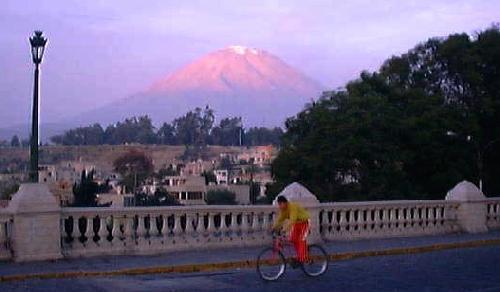
Volcan Misti, Arequipa
After Santa Catalina, we were met by our taxi driver, who drove us a little around Arequipa, taking us to a spot with a fantastic view of the mountains surrounding the city, especially the volcano Misti. The next day we took things easy, sitting around the house drinking coffee before going for a walk in the afternoon. Anparo took us into town, and we were simply walking around when we saw a sign advertising the Pasteleria Mostar, just a few doors down from the Hotel Tito. Anparo told us that the owner was from Yugoslavia, and we expressed an interest in meeting him. In fact, he was in another coffee shop, which he also owns, and his name was Lovro Bukovac. He had a map of Yugoslavia on the wall of this coffee shop, and was one of those people who speak in such a way that other people simply understand him whatever the language - Anparo understood him when he was speaking Serbo-Croat, and we understood him perfectly in Spanish.
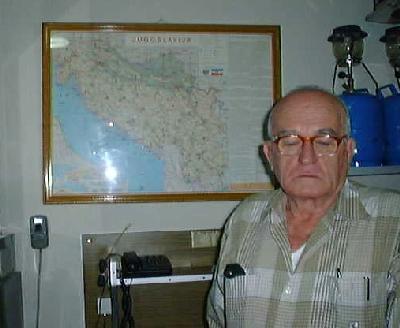
Lovro Bukovac, and map of Yugoslavia
The bus journey to Puno was very interesting - at one point the road petered out, and we were driving through a sandy desert with the route marked out only by the tyre tracks of other vehicles which had passed by. The scenery was spectacular, although it did become a little monotonous towards the end. We eventually arrived in Puno unscathed and found a room in the Hostal Europa near the market. We left a message for Eoin and found a pleasant restaurant to eat in. However, despite my repeated insistence that my Scottish friend would contact the hotel, when Eoin did call, the receptionist denied all knowledge of my existence.
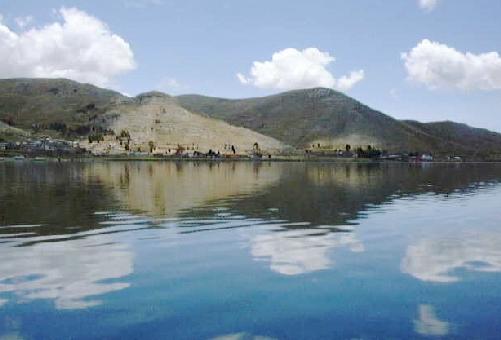
Beautiful Lake Titicaca
The next morning we caught a boat to the Islas de los Uros, the floating islands in Lake Titicaca. The islands are constructed of layers of totora reeds, which grow in abundance in the shallow waters of the lake around the bay of Puno. The Uros people took to their floating lifestyle in order to stay clear of the Collas and Incas. Over the years, they intermarried with Aymara people living on the shores of the lake, but maintained their island way of life. In addition to the islands, they also build their homes and boats from the totora reeds. The tourist boom has brought a certain degree of prosperity to the islands, and the locals milk it for all it's worth - they charge tourists to land on the islands, and everywhere you go there are stalls selling clothes, trinkets and other souvenirs, including some of the most beautiful ashtrays I've ever seen. I must say though that it is somewhat bizarre to see simple thatched huts with high-tech solar panels on the roofs! We ended up buying a woollen jacket for me and an alpaca sweater for Veronika from two delightful local women in traditional dress. The bargaining was hard but friendly and good-natured, as it should be, with me claiming abject poverty (not too far from the truth) and them pointing out that selling clothes was their only source of income. In the end, we got the two items for around $14. They allowed us to take a photo, and were delighted when I showed them the results on the display of our digital camera.
The best view of the islands came from the extremely rickety five-metre high viewing towers balanced precariously on the reeds. The platform on top was large enough in theory to take perhaps six or seven people, but fortunately we never had to put this theory to the test, as they wobbled alarmingly when just one person climbed the ladders to reach the top. Another highlight was the wacky birds which live on the islands (and which the 300 or so islanders eat alongside trout from the lake) and which swarmed around visitors' feet looking as though they were about to eat their shoes.
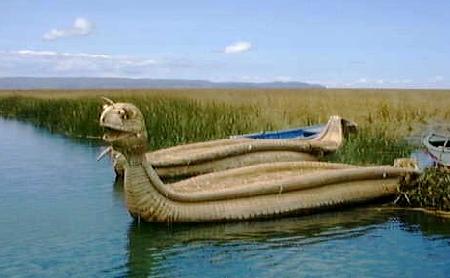
Totora boats, Isla de los Uros, Lake Titicaca
When we returned to Puno, I checked my email and found that Eoin had gone on an overnight trip to some other islands further out into the lake, so we decided to visit Sillustani the next day. Sillustani was a cemetery for the Wari people, and later for the Collas and the Incas. Simple graves of small stone circles gave way to elaborate twelve-metre high funerary towers with beautifully fitted rocks forming the outer layer. Noble families would have their own crypt. The location of Sillustani is spectacular; it sits on a hill at an altitude of 4000 metres overlooking a stunningly beautiful lake, the Laguna Umayu. In the middle of the lake is a large island with sheer cliffs rising to a mesa so flat that it makes the whole island look artificial.
We got back to the hotel in Puno just after 6 in the evening and were debating whether to go look for Eoin or to leave a note (we had tried to visit his hotel but it was all locked up, and I had left a telephone message with great difficulty earlier that day) when he turned up at our door. We chatted for a while and then went for some dinner in the little Italian restaurant we'd discovered on our first night. We swapped travellers' tales and had a couple of drinks over dinner and agreed to meet up later somewhere in Bolivia, a typically detailed plan!
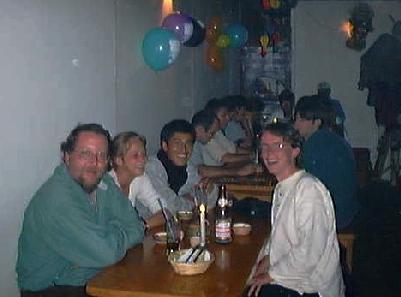
Eoin, Veronika, Fergus and friend, Puno
Next | Travel index | Family history | Romany | Main index